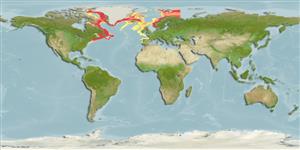Common names from other countries
Environment: milieu / climate zone / depth range / distribution range
Οικολογία
Θαλασσινό(ά) βαθύβιο(ς); εύρος βάθους 165 - 1342 m (Ref. 58426), usually 165 - 215 m (Ref. 42091). Deep-water; 79°N - 38°N, 76°W - 36°E
North Atlantic: English Channel, North Sea, Norwegian coastline, Svalbard, southwestern Barents Sea, off Spitzbergen, Bear Island, the Faeroes and Iceland, southeastern coasts of Greenland. Western Atlantic: New Jersey, USA to Gulf of St. Lawrence, Canada and Greenland.
Μέγεθος / Βάρος / Age
Maturity: Lm ? range ? - ? cm
Max length : 30.0 cm SL αρσενικό/απροσδιόριστο; (Ref. 35388); common length : 14.0 cm SL αρσενικό/απροσδιόριστο; (Ref. 6696)
Short description
Κλείδες προσδιορισμού | Μορφολογία | Μορφομετρία
Four bony knobs between and behind the eyes. Skin very rough. Body with 3-4 broad, dark vertical bands (Ref. 35388).
Benthic (Ref. 58426). Feeds on polychaetes, mysids, amphipods and pycnogonids. Spawns probably from June to July, ovarian eggs large and few (up to 220) (Ref. 6696). Female lays 200 eggs with a length of 4.5-5 mm (Ref. 35388).
Life cycle and mating behavior
Maturities | Αναπαραγωγή | Spawnings | Egg(s) | Fecundities | Προνύμφες
Fedorov, V.V. and J.S. Nelson, 1986. Psychrolutidae. p. 1261-1264. In P.J.P. Whitehead, M.-L. Bauchot, J.-C. Hureau, J. Nielsen and E. Tortonese (eds.) Fishes of the North-eastern Atlantic and the Mediterranean. UNESCO, Paris. Vol 3. (Ref. 6696)
IUCN Red List Status (Ref. 130435)
CITES (Ref. 128078)
Not Evaluated
Threat to humans
Harmless
Human uses
αλιεία: χωρίς ενδιαφέρον
Εργαλεία
Special reports
Download XML
Διαδικτυακές πηγές
Estimates based on models
Preferred temperature (Ref.
115969): 0.3 - 7.7, mean 2.6 (based on 243 cells).
Phylogenetic diversity index (Ref.
82804): PD
50 = 0.5039 [Uniqueness, from 0.5 = low to 2.0 = high].
Bayesian length-weight: a=0.00389 (0.00180 - 0.00842), b=3.12 (2.94 - 3.30), in cm Total Length, based on all LWR estimates for this body shape (Ref.
93245).
Τροφικό Επίπεδο (Ref.
69278): 4.1 ±0.2 se; based on diet studies.
Ελαστικότητα (Ref.
120179): Χαμηλό, ελάχιστος χρόνος για διπλασιασμό πληθυσμού 4,5 - 14 έτη (Fec = 66).
Fishing Vulnerability (Ref.
59153): Low to moderate vulnerability (27 of 100).
